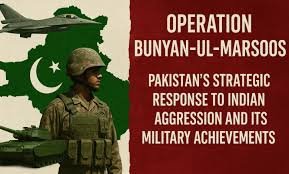Introduction
In the annals of South Asian military history, 2025 will be remembered as the year Pakistan launched its first full-scale strategic military response—Operation Bunyan-un-Marsoos. Named after the Arabic phrase meaning “a wall of solid lead,” the operation marked a turning point in Pakistan’s defense doctrine, showcasing its technological prowess, strategic depth, and national unity in the face of aggression.
This article explores the background, execution, and impact of Operation Bunyan-un-Marsoos, analyzing its military, diplomatic, and geopolitical significance.
Table of Contents
Operation Bunyan-un-Marsoos: Pakistan’s BEST Wall of Steel ON YOUTUBE
Background: India’s Operation Sindoor
On May 7, 2025, India initiated Operation Sindoor, a series of missile strikes targeting six Pakistani cities: Muzaffarabad, Sialkot, Kotli, Bhimber, Daska, and Gujrat. These attacks resulted in over 30 civilian deaths and dozens of injuries, sparking outrage across Pakistan. The strikes were seen as a violation of international norms and a provocation that demanded a decisive response.
Pakistan initially exercised restraint, engaging in diplomatic outreach and mobilizing its defense systems. However, continued aggression and disinformation campaigns from India led Pakistan to launch Operation Bunyan-un-Marsoos on May 10, 2025.
Air Superiority: The Largest Dogfight in South Asia
The operation began with a massive aerial engagement—the largest in South Asian history. Over 125 fighter jets were involved in the dogfight:
- Pakistan Air Force (PAF) deployed 42 aircraft, including JF-17 Thunder, F-16 Fighting Falcons, and J-10C multirole jets.
- Indian Air Force (IAF) fielded 80–83 jets, including 14 Rafale fighters, SU-30MKIs, and MiG-29s.
Key Outcomes
- PAF shot down five Indian aircraft, including three Rafales, one SU-30, and one MiG-29, without losing a single jet.
- Pakistan’s jets successfully evaded and neutralized India’s S-400 missile defense system, using advanced AI-powered jamming and tracking systems.
- The air battle demonstrated Pakistan’s ability to achieve air superiority even against numerically superior and technologically advanced adversaries.
Missile and Drone Defense
India’s use of BrahMos cruise missiles and Israeli-made drones was met with a robust Pakistani defense:
- BrahMos missiles targeting Dinga and surrounding areas were intercepted mid-air by Pakistan’s integrated missile defense system.
- Swarms of drones were neutralized using AI-guided anti-drone systems, preventing damage to civilian and military infrastructure.
- Pakistan’s electronic warfare units jammed Indian communications and disrupted drone navigation.
Ground Operations: Tactical Precision
While the air and missile battles dominated headlines, Pakistan Army executed surgical ground operations along the Line of Control (LoC):
- 26 high-value Indian targets were destroyed, including brigade headquarters, bunkers, and forward operating bases.
- Pakistan’s artillery and special forces launched precision strikes, minimizing collateral damage and avoiding civilian casualties.
- India’s retaliatory attempts at seven locations were repelled with superior coordination and firepower.
Naval Readiness: Securing the Seas
Pakistan Navy played a crucial role in securing maritime boundaries:
- Surveillance of Indian naval movements in the Arabian Sea was intensified.
- Submarine and surface fleets were placed on high alert, deterring any naval aggression.
- Coastal defense systems were activated to protect strategic ports and economic zones.
Diplomatic Front: Global Support and Strategic Alliances
Operation Bunyan-un-Marsoos was not just a military success—it was a diplomatic victory:
- China, Turkiye, and Azerbaijan expressed strong support for Pakistan’s right to self-defense.
- The United Nations acknowledged Pakistan’s restraint prior to launching the operation.
- A landmark Pakistan–Saudi Arabia Defense Pact was signed, enhancing Pakistan’s regional influence and strategic depth.
This diplomatic momentum helped Pakistan counter India’s narrative and gain international legitimacy for its actions.
Economic Impact: Stability Amid Crisis
Contrary to expectations, the operation had a positive economic impact:
- The International Monetary Fund (IMF) approved a $1 billion support package, citing Pakistan’s stability and responsible conduct.
- Stock markets showed resilience, with investor confidence buoyed by Pakistan’s effective crisis management.
- Defense exports and strategic partnerships saw an uptick, especially in drone and missile technologies.
Information Warfare: Winning the Narrative
India launched a massive disinformation campaign, claiming exaggerated victories and spreading fake news. Pakistan countered this with:
- Real-time updates from ISPR (Inter-Services Public Relations), backed by satellite imagery and verified footage.
- Collaboration with independent journalists and international media to ensure transparency.
- Social media campaigns that highlighted Pakistan’s restraint, precision, and humanitarian considerations.
This helped Pakistan win the information war, both domestically and internationally.
National Unity: A Moment of Patriotism
Operation Bunyan-un-Marsoos ignited a wave of national unity:
- Citizens across provinces rallied behind the armed forces.
- Social media was flooded with patriotic messages, art, and tributes.
- Youth engagement surged, with volunteer drives and defense awareness campaigns.
The operation became a symbol of resilience and pride, reinforcing the bond between the military and the people.
Historical Significance
Operation Bunyan-un-Marsoos is now considered a watershed moment in Pakistan’s defense history:
- It marked the transition from reactive defense to proactive strategic deterrence.
- Showcased Pakistan’s ability to integrate AI, cyber warfare, and precision targeting.
- Set a precedent for multi-domain warfare, involving air, land, sea, and digital fronts.
Strategic Analysis
- Military: Pakistan demonstrated technological parity and tactical superiority.
- Diplomatic: Gained allies and strengthened global standing.
- Economic: Maintained stability and attracted strategic investments.
- Informational: Controlled the narrative and exposed misinformation.
Conclusion
Operation Bunyan-un-Marsoos was more than a military campaign—it was a statement of resolve. Pakistan proved that it could defend its sovereignty with precision, restraint, and unity. The operation reshaped regional dynamics, deterred future aggression, and elevated Pakistan’s status as a responsible and capable power.
______________________
YOU MAY ALSO LIKE:


